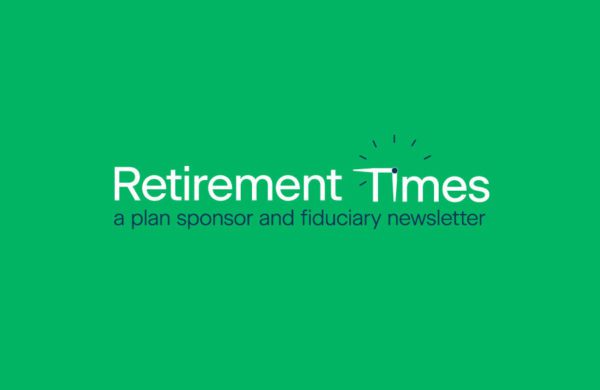3(38) Advisory Services – Should Fiduciaries Outsource Retirement Plan Investment Responsibility?
Department of Labor (DOL) enforcement recoveries are on the rise. A recent DOL report indicates that DOL recoveries have doubled since 2018 and tripled since 2016 (https://www.investmentnews.com/dol-retirement-plan-recoveries-198660). As a result, fiduciary liability premiums have increased 35 percent since last year (https://www.investmentnews.com/fiduciary-insurance-costs-401k-litigation-198407).
Fiduciaries are personally responsible for participant losses resulting from a fiduciary breach. Plan sponsor fiduciaries who handle plan investments themselves, or use advisors who do not assume fiduciary status, face potential exposure for both investment performance and all plan fees.
The Employee Retirement Income Security Act of 1974 (ERISA) specifies that any plan fiduciary level decision must be informed by expertise. Most plans do not have a credentialed investment expert on committee (if they do, that individual is typically not amenable to accepting the responsibility and liability involved). Plan sponsors who are wont to mitigate this liability for investment decisions (investment menu structure, selecting and monitoring plan investment options) have specific options available under ERISA.
ERISA 3(21) Investment Advisor
The most utilized mitigation option and perhaps most suitable for many plans is hiring an ERISA 3(21) investment advisor. An advisor acting in a 3(21) capacity is responsible for delivering unbiased prudent investment recommendations regarding the selection and ongoing monitoring of plan investments. The DOL has made clear that it is the responsibility of the plan investment fiduciaries that the final selection be commensurate with their participants’ needs. Your advisor has access to a Qualified Default Investment Alternative (QDIA) selection tool. This tool is used to determine and document the participant demographic investment appropriateness for a QDIA, thus eligible for a fiduciary “QDIA safe harbor.” This same tool can also aid in making an appropriateness determination for individual investments as well.
ERISA 3(38) Investment Advisor
Section 402 of ERISA allows plan fiduciaries to delegate investment responsibilities to, what ERISA calls, a “named fiduciary.” This named fiduciary is a 3(38) investment advisor who assumes all responsibilities for selection, monitoring, and participant demographic appropriateness for plan investments. The company is then left with only monitoring that the advisor retains a prudent analytic process (e.g., their analytic process does not deteriorate substantially from its original prudent level). The 3(38) advisor needs to work with the client to determine investment appropriateness on issues such as risk, expense and style appropriateness, but once accomplished, substantially more meeting time is available for other important topics like fiduciary education, plan success, participant retirement readiness and more.
Former Employees with Plan Assets are Still Plan Participants
Plan sponsors should understand that terminated employees who left their account balance in your plan are still considered participants under ERISA. As such, they have the same rights as current employees. They cannot contribute to their account under the plan, but otherwise they have the same ERISA protected rights as plan participants.
One protected right is to receive all ERISA required notices that current participants receive. The distribution of notices to former employees can be challenging. With online notice distributions now allowed, it may ease this problem a bit, but losing track of former employees through undeliverable mail or emails can be troubling.
Participant direction of investments and notice of investment changes is another obligation that is more difficult with terminated employees. A fundamental fiduciary responsibility is to provide sufficient investment information such that participants can make consistently informed investment decisions. In the event the stock market goes through a bear market cycle, former employees may become disgruntled if they did not receive proper and required investment information based on which they may have prevented financial losses.
Small account balances belonging to former employees can be problematic for plan providers as well as plan fiduciaries. This can lead to greater administrative recordkeeper costs. In addition, having terminated employees in your plan may cause your plan to be subject to an annual plan audit at a potential cost of around $15,000.
One step many plans take to mitigate this exposure to some extent is to adopt a cash-out limit (usually $1,000 or $5,000). With a cash-out limit, terminated participant accounts may be distributed after communicating that they need to take a distribution directly or a rollover to an Individual Retirement Account or another qualified plan. For participant accounts in excess of $5,000, you must obtain consent from employees requesting to take their account balances out of the plan. It is advantageous for plan sponsors to persistently reach out to former employees to request they take their money out.
The Department of Labor (DOL) has been focused on missing participants with dormant accounts. As with any fiduciary task, as part of your annual request that former employees take their money, it is advisable that all correspondence (both sent and returned) be documented to evidence your communication efforts. Internet searches can be helpful to find those who leave no forwarding address.
Should You Adopt a Plan Committee Charter?
Yes!
The primary purpose of a committee charter is to document overall plan governance. It is not dissimilar to how your Investment Policy Statement (IPS) acts as a “roadmap” for managing your plan investments. The charter also documents delegation of fiduciary responsibilities from the plan’s “named fiduciary” to
co-fiduciaries. Even small plans with a single fiduciary who makes all plan management decisions can benefit from having a plan governance document.
But simply having a committee is not sufficient. Per ERISA, a retirement plan governance committee charter sets out the committee’s goals and responsibilities. It should include certain specific fiduciary principles, such as managing the plan for the exclusive benefit of participants, practicing ERISA’s procedural prudence, adhering to the plan document and ensuring proper diversification of investment options.
Committee members should sign the charter initially stating that they understand and accept responsibilities as a plan fiduciary, and resign when retiring from the committee if they remain with your company.
What is a Named Fiduciary?
Every plan document is required to identify the plan’s “named fiduciary.” This can be a specific individual, an entity, or most frequently, “the company” can be the named fiduciary. “The company” as the named fiduciary denotes the main decision-making person or entity (e.g., the party with authority to adopt the plan). For a “C Corporation” this would be the board of directors. The board of directors, as the named fiduciary, can never delegate all its fiduciary responsibility, but via committee charter it can delegate nearly all plan fiduciary responsibilities (except the responsibility of prudently selecting and monitoring the plan’s committee members who serve as fiduciaries) to co-fiduciaries (e.g., committee). As a result of this monitoring requirement, the committee needs to keep the board (named fiduciary) informed of its activities and to approve its recommendations on key items which may not have been delegated.
Who, What, When and Why of the Committee
Given the high level of the committee’s responsibility, a representative of top management should play a key role on the committee.
The number of committee members varies, but one should consider having an uneven number of committee members to avoid any voting ties. Typically, medium and larger plans committees will have three, five or seven members. Some plans will have a separate investment committee if in-house investment knowledge is available. It is important that committee members can make a contribution, and are agreeable, to participating in committee activities.
Most medium and larger plan committees will meet with their plan advisor on a quarterly basis discussing and documenting topics covered such as: investments; participant behavior/retirement readiness; funding; administration; plan goals/objectives plan administrative processes and general plan management. Committees may occasionally invite a third party to a meeting who represents a specific plan function (plan administration, representing a specific employee group, CEO, etc.).
It is expected that all committee members attend meetings regularly. Those that do not, or otherwise demonstrate a lack of commitment to their role, should be considered for potential removal and/or replacement. If a members with specific expertise important to the plan leave the committee, they need to be replaced by someone with the same expertise.
All committee topics and decisions should be thoroughly and carefully considered, in accordance with ERISA procedural prudence, and then documented in committee meeting minutes. If the decisions have an ongoing impact on the plan, those decisions should be reviewed periodically to ensure their continued prudence.
All committee members should receive training on their fiduciary responsibilities under ERISA, their liabilities (and mitigation strategies), plan operations and plan administration. During an annual plan audit (required for plans with 100+ participants) or a DOL investigation, it is typical for evidence of the frequency of fiduciary training for committee members be requested.
ERISA requires retirement plan fiduciaries to exercise their authority “with the care, skill, prudence and diligence under the circumstances then prevailing that a prudent person acting in a like capacity and familiar with such matters would use in the conduct of an enterprise of a like character and with like aims.” This standard of “…a prudent person acting in a like capacity and familiar with such matter…” means having or obtaining expertise pertaining to each matter under consideration. As an example, when considering an investment decision, credentialed investment expertise is a best practice whether in-house or with a credentialed fiduciary plan investment advisor.
Personal Financial Fiduciary Liability Mitigation
As a plan fiduciary, you may become personally financially liable for any breach of duty that causes financial detriment to your plan participants. Retirement plans that operate without a coherent governance structure are susceptible to mismanagement, potentially incurring personal financial legal liability for imprudent or ill-informed decisions. There are effective strategies for mitigating this potential liability. Understanding your ERISA fiduciary responsibilities, liabilities, clearly and administering your plan document accurately are most important.
Obtaining ERISA fiduciary liability insurance and/or company indemnification should be considered.
By creating an effective plan governance committee, including ongoing fiduciary education, your plan management can operate effectively for the benefit of plan fiduciaries and plan participants.
Securities offered through Kestra Investment Services, LLC (Kestra IS), member FINRA/SIPC. Investment advisory services offered through Kestra Advisory Services, LLC (Kestra AS) an affiliate of Kestra IS. Kestra IS and Kestra AS are not affiliated with Higginbotham.
The “Retirement Times” is published monthly by Retirement Plan Advisory Group’s marketing team. This material is intended for informational purposes only and should not be construed as legal advice and is not intended to replace the advice of a qualified attorney, tax adviser, investment professional or insurance agent. (c) 2018. Retirement Plan Advisory Group.


